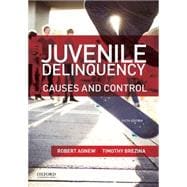An essential resource for exploring juvenile delinquency in the twenty-first century, Juvenile Delinquency: Causes and Control, Fifth Edition, offers a clear and concise overview of the latest theories and research on the causes and control of delinquency.
Instead of attempting to provide a sweeping view of the entire subject, Robert Agnew and new coauthor Timothy Brezina organize the text around three major questions: What is the nature and extent of delinquency? What are the causes of delinquency? What strategies should we employ to control delinquency? These thought-provoking questions draw students into the text, challenging them to use major theories to explain the basic facts about delinquency, to understand the research on its causes, and to develop and evaluate programs and policies for its control.








